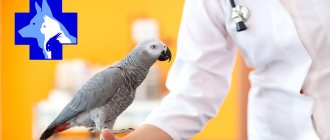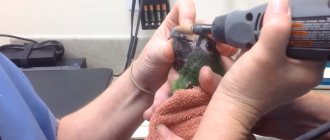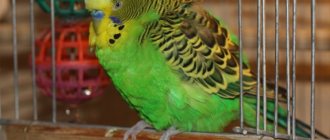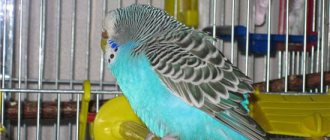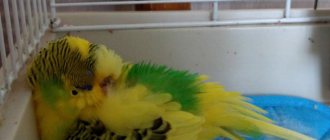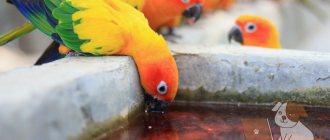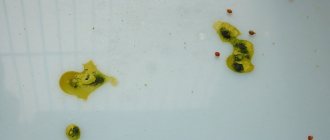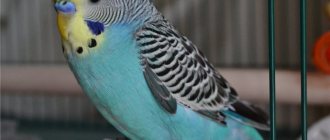Reasons for strange behavior
Any deviation from the norm in the bird’s behavior should alert its owner. These are the first signs of physical and psychological discomfort. The reason may be a sharp cold snap. If the bird is trembling and hiding its head, this may indicate malaise.
The parrot is shaking: reasons
- Low indoor temperature. You need to check if the window is locked. Perhaps the cage is in a draft. In winter, it is better to turn on the lamp near the bird house. At night, the cage with the parrot is covered with a blanket. During molting, the bird may freeze from loss of fluff. During this period, it is advisable to increase the air temperature in the room by several degrees.
- Sharp sounds and movements cause trembling in parrots. If there are large pets in the house - cats or dogs, they often cause fear and stress in the pichuga. Loud barking and attempts by the cat to break into the cage exhaust the nervous system of the little bird. It is necessary to protect her from such attempts.
- Children's screams and noisy behavior can also frighten the bird. At the same time, she will get ruffled, hide her head under her wing and tremble with fright.
- Change of residence and owner. For the psyche of a young chick, these factors are not as traumatic as for an adult. The parrot gets used to the house and the person. If you had to change your place of residence, the parrot worries about this. He needs time to adapt. Trembling is one of the signs of stress.
- If other symptoms are added to the trembling and ruffled feathers, it is likely that your pet is sick. Sneezing, liquid droppings, lethargy and drowsiness are signs of diseases not associated with hypothermia or stress.
- In the spring, a lack of vitamins or a poor diet can cause vitamin deficiency. It is manifested by a lethargic state of the bird, trembling, and poor appetite. It is necessary to review his diet and add vitamin complexes to the diet.
- Trembling in the body, closed eyes and ruffled feathers with a good appetite and lack of stool may indicate the development of pathologies of the digestive system. In this case, the bird must be urgently shown to a veterinarian. For some reason, the bird develops an obstruction. This pathology should be treated urgently.
On a note! If your parrot is becoming ruffled and closing its eyes even after warming up and stressors have been removed, you should look for other signs of deteriorating health.
Stress
Constant boredom or serious changes in the usual life of the handsome winged creature can lead to sudden overexertion. For example, his partner died, the owner or place of residence changed. The cause of stress can be a new, unusual food that your pet doesn’t like. Or the cage was moved to an unfamiliar place, far from all family members. Perhaps there are new noisy animals or small children in the house.
When stressed, a parrot often hides its beak under its wing. At the same time, he becomes lethargic, may pluck himself and eat poorly. You should think about why your winged friend behaves this way and help him. In this state, the bird becomes susceptible to diseases. Depression may develop, which threatens the pet's mental state and can lead to its death.
Dangerous symptoms that may accompany a parrot with chills
The parrot's trembling, lethargy and closed eyes may indicate not only its hypothermia. If the cause is illness, then other symptoms will appear within 3 days. It is important to identify them as early as possible.
Clear signs of dangerous diseases:
- a bent leg tucked under the body or a drooping wing indicates dislocations and fractures;
- small purulent or bleeding wounds on the body - may indicate various skin diseases;
- digestive disorders: diarrhea, constipation, vomiting;
- lack of appetite, sleepiness, immobility indicate colds or poisoning;
- baldness with itching and redness of the skin indicates the presence of parasites in the bird;
- trembling with convulsions, loss of appetite, hoarseness, uncharacteristic sounds that the pet makes - this is a cold or goiter.
On a note! If the parrot is crested and trembling, or other dangerous symptoms appear, it is necessary to conduct an examination at a veterinary clinic.
Diseases of the budgerigar accompanied by trembling
Frequent diseases that are accompanied by trembling are:
- A symptom of poisoning is trembling. Digestive disorder.
- Cold.
- Infectious diseases.
- Diseases of internal organs.
- Poisoning.
- Parasitic diseases.
In addition to trembling, the pet experiences weakness, difficulty breathing, and its eyes are usually closed. Since the parrot quickly loses strength, it sits at the bottom of the cage. Self-diagnosis and treatment are not advisable; immediate consultation with a doctor is recommended.
How can you help your parrot at home?
Often, trembling that is not accompanied by other dangerous symptoms can be easily eliminated. The pet needs to be warmed and calmed.
Stress management
Moving is a common cause of mental discomfort for a parrot. Changing his cage is no less stressful for him. At the same time, the pet will begin to get nervous, cackle, and tremble. The owner may not immediately determine the cause of this condition. To calm the bird, you need to talk to it quietly and affectionately. You can stroke and caress your pet if it is tame. The old drinking bowl, feeder, and perches are installed in the new cage. You need to move your favorite toy to a new place. This way, moving to a new house can be made less traumatic.
First aid for illnesses and hypothermia
In case of dislocations and fractures, the bird is immobilized. The bottom of the cage is covered with straw. The damaged limb is bandaged, and the pet is warmed with a lamp or blanket.
An open wound must be treated with a gentle antiseptic. Hydrogen peroxide is suitable for rinsing. The cage also needs to be wrapped. Warmth will help the bird get rid of chills.
For colds and hypothermia, the bird is warmed up and given a warm infusion of chamomile (1 tbsp per 1 cup of boiling water). A regular tabletop lighting device is installed next to the cage. The lamp for it is chosen with a power of 40–60 W, no more. The light should be directed at the cell at all times until the signs of hypothermia disappear. The lighting device cannot be placed at a distance of less than 20 cm from the cage. The air temperature in the bird house should warm up to + 30 C°. One half of the cage should be covered with a blanket to create shade. As soon as the bird becomes uncomfortable or hot, it can always hide in such a shelter. Warming is carried out while the feathered pet is awake. Do not leave the lighting fixture overnight. The lamp exposure time should not exceed 4 hours.
As soon as the parrot stops tucking and hiding its head, the lighting can be turned off. It is important to prevent heat stroke.
In winter, heaters are installed in the room. It is good to humidify the air periodically.
On a note! The temperature in the cage should be monitored when installing the lamp. A high, uncomfortable temperature is just as dangerous for a parrot as a low one. The optimal level is +25 Сᵒ.
Prevention
A tamed bird should be given more attention. The parrot must be kept in a standard cage, avoiding drafts, hypothermia and overheating. In winter, you cannot open the window on which there is a cage with a bird. In sunny weather, you need to keep a towel ready to protect the perroque from the burning rays.
You should not feed your parrot just anything. Professionals have developed special food for different breeds of birds. It is balanced in vitamins and other nutrients. It is necessary to protect your pet from excessive noise and contact with predators. When moving or moving, it is useful to give the anti-stress multivitamin drug “Radostin” - 3 days before and 3 days after the trip.
Radostin
Man is responsible for those he tames. If he is attentive to his pets, they will get sick less.
We invite you to join our Zen channel and group on VKontakte or Odnoklassniki, where new articles for pet owners are published.
Similar articles:
- Top 5 Mistakes of Budgerigar Owners
- Feeding the finch correctly
- Fleas on a parrot: how to help an exotic bird?
How to prevent your feathered pet's condition from getting worse
For a long and healthy life of a parrot, it is important to comply with all the conditions of its maintenance. It is important to carefully monitor his behavior and the slightest deviations from the norm. If a parrot raises its feathers, puffs itself up, has its eyes closed, and hides its head under its wing, this is hypothermia.
Temperature is an important factor for the health of a pet parrot. Variegated birds naturally live in hot countries. Warmth is their natural habitat. But they also do not tolerate heat well. The optimal comfortable temperature should range from +22…+25 C°. It is allowed to drop to +18 Cᵒ, but no more than an hour. This temperature is not comfortable for heat-loving birds and can cause the development of colds.
Higher temperatures and dry air provoke the appearance of skin diseases. This may be itching, loss of feathers, dry mucous membranes. As a result, the parrot begins to lose appetite and may get sick.
Chills and ruffled feathers are not symptoms of serious illness. Heating and a calm environment in the house will quickly relieve your pet from discomfort. If all the conditions are met, and the bird only gets worse, it is important not to ignore other symptoms. If the disease is detected at an early stage, it responds well to treatment.
Goiter inflammation
This is a disease of granivorous birds, often occurring with vague symptoms. The main symptom is inflammation of the goiter sac. In addition, the bird:
- shakes and stretches his neck;
- behaves restlessly;
- constantly regurgitates food;
- becomes lethargic;
- refuses food.
In advanced cases, the parrot spits out food, the mucous membranes become bluish, and the crop sags. The pet cannot swallow at all, its beak often opens, viscous saliva appears, and the feathers on its head stick together. The bird subsequently dies. This condition leads to:
- poor quality food;
- poisoning from toxic plants or chemical vapors;
- complication after infectious diseases.
It happens that a bird does not receive the necessary mineral elements and compensates for them by stuffing its crop with grain, which leads to inflammation.
The disease is often detected at a stage when it is practically impossible to help the pet. As a rule, treatment at home cannot save the bird; an urgent visit to the veterinarian is necessary. It is important not to miss the symptoms and find out why your pet parrot's head begins to shake.
For this purpose, an examination is carried out. Antibiotics are used only if the infectious origin of the disease is confirmed. In parallel with the main treatment, medications are given to support the liver. To avoid exhaustion, the bird is fed liquid porridge.
Treatment
Every owner should be able to provide first aid to their pet. In case of a cold, it is enough to warm the parrot (turn on the infrared lamp near the cage) and soak it in chamomile infusion.
Poisoning is a particular problem: small parrots metabolize very quickly. Once in the body, toxins immediately penetrate all systems. A fluffy parrot with its eyes closed unknowingly indicates that it needs immediate treatment. Sometimes it takes hours to count.
The procedure for eliminating intoxication is as follows:
- Dilute the sorbent (enterosgel, activated carbon, polysorb) with water and inject it into the beak in small portions. You can use a needleless syringe or dropper.
- Boil the rice in water until fully cooked, grind into a liquid porridge and let cool to room temperature. Place the food in the syringe and gently feed your parrot. One meal requires 1.5 ml of porridge.
- Poisoning is accompanied by vomiting and diarrhea. Keep feathers clean and clean the cage often.
A parrot flutters around under different circumstances, and this is not always a cause for concern. However, if the bird sticks to the corner of the cage and lies on its belly, it should not be left unattended. There are several reasons for this behavior: poisoning, illness or injury. When the first symptoms disappear and the parrot feels relieved, take him to the veterinarian.
Are there preventive measures?
Despite the fact that parrots are quite unpretentious to their living conditions, they still need comfort and coziness. The homeland of these birds is in countries with hot climatic conditions, for this reason they need the same conditions in captivity. Hypothermia can be fatal for this species of bird; in particular, they can develop kidney disease, which is difficult to treat.
As a preventive measure against the occurrence of any disease, it is to avoid drafts and sudden temperature changes, since they are delicate and sensitive creatures and are so easily susceptible to colds.
They can easily catch an infectious disease from their owners, so if you are sick, do not go near them under any circumstances, most likely they will get infected from you, and it will not be so easy to cure them.
And most importantly, you should not take on the treatment of a parrot on your own, because you will still not be able to provide highly qualified assistance, and you will miss out on valuable time. Due to the fact that the metabolism of parrots is carried out at a high speed, all diseases in them develop extremely quickly. So, don’t be late and save your pet!
Desire to breed
Owners of ornamental birds sometimes observe strange behavior in their pets: the parrot sits for a long time on the floor of the cage in the corner, then shakes itself and flies up onto a perch. It is impossible to tell from his appearance that there is cause for concern. Such actions indicate that the parrot is preparing for procreation.
Pregnant parrot
If there is a pair of mongrels living in a cage, this may be a sign that breeding has begun. It is worth supporting your pets' instincts by wearing a flap for them. However, if the only inhabitant of the household is a female parrot, then it is imperative to suppress her desire to reproduce. The mirror, twigs and paper should be removed from the cage. There should be no materials inside that can be used to build a nest. False incubations should be stopped, otherwise the parrot will lose its health in vain.
Improper feeding
The budgerigar is an active bird that is constantly on the move. A healthy parrot jumps from branch to branch, walks along the bottom and pecks grains, tears paper, but will not sit on the floor of the cage. So it’s not entirely clear why the parrot suddenly spends a lot of time downstairs. Probably his paws get tired of sticking to the perch and it’s more convenient for him to sit on the tray. The reason for this condition is poor nutrition: too much fatty food or lack of nutrients.
Obesity in a parrot
You should feed your pet not on demand, but on time, observing portion sizes. If you do not follow a diet, your parrot will become accustomed to overeating due to excess weight. A heavy body puts stress on the legs and wings. An obese bird has difficulty moving and is simply uncomfortable.
Monotonous food
A word of warning! It should also be noted that fasting is one of the causes of weakness in birds. The food may be of poor quality, and the parrot may not get enough of it. In some cases, malnutrition may be caused by switching to another food that the bird does not like.

